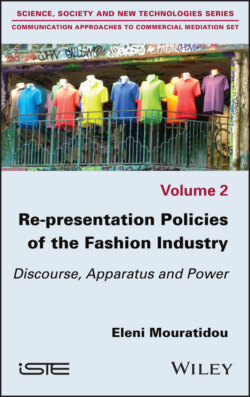Читать книгу Re-presentation Policies of the Fashion Industry - Eleni Mouratidou - Страница 15
I.7. Fashion and communication
ОглавлениеBefore presenting the theoretical and methodological point of view developed throughout this book, it is necessary to justify the link between the object of fashion research and its place within the ICS.
In outlining The Fashion System (1990), Barthes attempted to establish the grammar that could structure this language and consider fashion as a discourse. An exhaustive project, it became obsolete in the year of its publication: “From the very first pages of The Fashion System, [Barthes] confessed [...] the vanity and failure of his project. It was aimed at fashion; it reached only discourse, small, frustrated texts running on the pages of magazines” (Badir 2014, author’s translation). Before Barthes, it was Greimas (2000) who attempted, in his thesis, to describe the vocabulary of fashion through a study of fashion journals from 1830, offering, like Barthes, a sort of lexical encyclopedia of the practice of clothing as staged by media actors.
In the 1970s, it was the turn of sociologists Pierre Bourdieu and Yvette Delsault to take an interest in the atypical object of fashion and to point out the mechanisms that enable it to establish systems of domination (Bourdieu and Delsault 1975, pp. 7–36). Few works introduce this broad object into the ICS. Jeanne-Perrier (2016) analyzed the way in which the Internet has transformed fashion from the point of view of its mediation practices as well as from the point of view of mediatization. Actes sémiotiques devoted a dossier to the semiotics of clothing in 2014 (Mathé 2014). Research on the creative industries and their socioeconomic models studies the way in which luxury in general submits to issues of symbolic industrialization (Bouquillion et al. 2013). Findings such as that of Lipovetsky and Roux (2013) are often mobilized in the ICS in order to highlight the new aspirations of fashion, which the two authors describe as hedonistic consumption, by emphasizing the changes in the sector and also its marketing strategies. Finally, works within the scope of fashion studies approach fashion, its practices, its mediations and media coverage from multidisciplinary points of view, the specificity of fashion studies being the entry into the subject by the object and not by the scientific framework (Mendes and Rees-Roberts 2015, pp. 53–69). This research is significant, but the object “fashion” as a clothing practice, a mediating body, media coverage, industry, etc., remains peripheral in the ICS. However, the sector is arousing a definite interest by the diversity of the communication processes involved and also by the constant evolution of its models, which is taken into consideration more during higher studies.
To take an interest in the object of “fashion” from a communicational point of view is to try to grasp the complexity of a creative industry as much from the point of view of the processes of production, manufacture and distribution of its goods as per its inscription in the public space. Finally, at a time when luxury fashion and in particular its representatives such as the heads of the dominant groups in the sector occupy a certain media position and are also seeking to occupy a political position,30 it seems to me necessary, even essential, to take an interest in this object and to focus on the way in which what we call fashion in general is a multiplicity of gestures, practices, strategies and tactics and constitutes an object whose communicational processes need to be questioned from the point of view of what Jeanneret (2014) calls media capitalism.
